|
|
|
Sort Order |
|
|
|
Items / Page
|
|
|
|
|
|
|
| Srl | Item |
| 1 |
ID:
131979
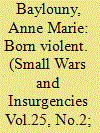

|
|
|
|
|
| Publication |
2014.
|
| Summary/Abstract |
We know little of the internal governing practices of non-state actors once in control of territory. Some territories have witnessed the establishment of new institutions of public goods remarkably similar to state institutions. This article compares four armed political parties governing territory during the Lebanese civil war. These non-state violent actors established complex political and economic institutions and administrative structures. Despite the wide range of ideologies and identities of these actors, they all converged in their institutional priorities, although not in their capacities or the particular ways of achieving those priorities. Data from interviews and the actions of the armed political parties suggest a combination of ideology and desire for control is causal in generating public institutions, partly attributable to the high degree of citizen activism marking the Lebanese case.
|
|
|
|
|
|
|
|
|
|
|
|
|
|
|
|
| 2 |
ID:
124710
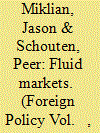

|
|
|
|
|
| Publication |
2013.
|
| Summary/Abstract |
It's a June night in Kinshasa, and rapper JB Mpiana's weekly VIP bash is just starting to heat up. Toned groupies splash like mermaids in a sunken pool. Middle-aged businessmen perch on the ledge above to watch. A minute before midnight, JB runs onstage among a huge posse of gyrating dancers in sunglasses. He rips into some of his biggest hits; a bombastic performer, he glides across the stage with a beefy grace, dressed in a hunter-orange jumpsuit and matching cap.
Most songs deal with the usual material, girls and gangbangers, in the Democratic Republic of the Congo's Lingala language. But when JB starts to chant the lyrics of his biggest hit of the night, the real purpose of this party -- festooned with yellow-and-blue banners advertising Primus, the beer that everyone would be drinking anyway, even at this lush downtown wine bar -- becomes obvious.
|
|
|
|
|
|
|
|
|
|
|
|
|
|
|
|
| 3 |
ID:
082061
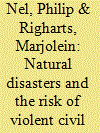

|
|
|
|
|
| Publication |
2008.
|
| Summary/Abstract |
Does the occurrence of a natural disaster such as an earthquake, volcanic eruption, tsunami, flood, hurricane, epidemic, heat wave, and/or plague increase the risk of violent civil conflict in a society? This study uses available data for 187 political units for the period 1950-2000 to systematically explore this question that has received remarkably little attention in the voluminous literature on civil war. We find that natural disasters significantly increase the risk of violent civil conflict both in the short and medium term, specifically in low- and middle-income countries that have intermediate to high levels of inequality, mixed political regimes, and sluggish economic growth. Rapid-onset disasters related to geology and climate pose the highest overall risk, but different dynamics apply to minor as compared to major conflicts. The findings are robust in terms of the use of different dependent and independent variables, and a variety of model specifications. Given the likelihood that rapid climate change will increase the incidence of some types of natural disasters, more attention should be given to mitigating the social and political risks posed by these cataclysmic events
|
|
|
|
|
|
|
|
|
|
|
|
|
|
|
|
| 4 |
ID:
096026
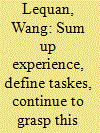

|
|
|
| 5 |
ID:
134153
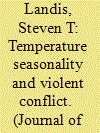

|
|
|
|
|
| Publication |
2014.
|
| Summary/Abstract |
Current climate change research suggests that certain seasonal weather patterns will be extended and others attenuated as global temperature increases. This is important because seasonal temperature change affects both the scarcity of resources during certain times of the year and the overall mobility of people living in countries that have seasonality. Consequently, these seasonal changes have implications for the onset of violent conflict, particularly as it relates to distinguishing when, where, and how it is most likely to occur. This article evaluates the relationship between monthly temperature changes, civil war onset, and various, less-organized conflict events, offering theoretical expectations for how seasonal changes and climate aberrations are related to an increased risk of violence. The results show that prolonged periods of stable, warm weather are consistently associated with an increased risk of civil war onset and non-state conflict. These findings are best explained through the strategic viability mechanism of temperature change, which allows actors to resolve their collective action problems that are often associated with poor weather conditions, while simultaneously increasing their strategic and behavioral incentives for engaging in violent conflict. Warm weather generates more resources for rebel looting and permits predictability for coordinating troop movements and strategy development. These findings are particularly salient in areas of the world affected by strong seasonality, where prolonged extensions of warm weather conditions would be regarded as both peculiar and attractive for participating in violent action. Although these findings are notable, even under the most extreme climate change scenarios, the substantive effects for these relationships are comparatively minor relative to other well-known intrastate Conflict Covariates.
|
|
|
|
|
|
|
|
|
|
|
|
|
|
|
|
| 6 |
ID:
144451
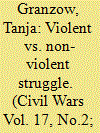

|
|
|
|
|
| Summary/Abstract |
Why do some opposition movements escalate into armed conflict while others abide non-violently under very similar conditions? In order to account for this variance, the article proposes to transcend the limitations of existing structural theories within civil war studies by including a framing perspective. It accentuates and elucidates the agency component and the interactive dynamics of the construction and negotiation of meaning, which remain a ‘black box’ in current models. In a comparative study of two movements in Yemen, the article identifies and describes the respective collective action frames, establishes why and how strategic movement actors construct them in their specific particularity, and relates this to the question of why constituents take certain forms of action. The findings assert the theoretical contribution of an integrative approach.
|
|
|
|
|
|
|
|
|
|
|
|
|
|
|
|
|
|
|
|
|